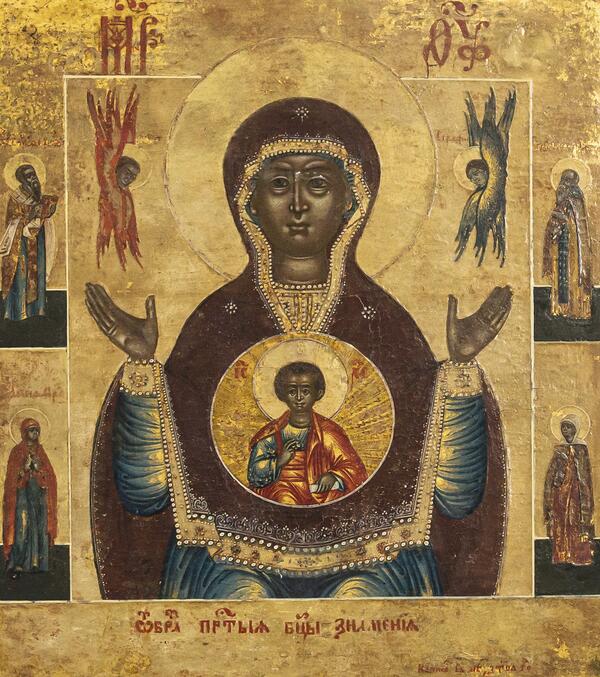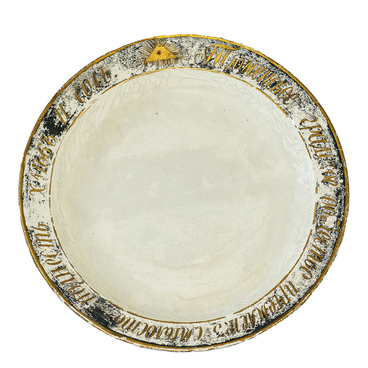The icon displayed is the “Our Lady (Mother of God) of the Sign” type, one of the most revered images in Russian Orthodoxy.
The oldest known Russian icon of “Our Lady of the Sign” is a Novgorod icon from the 12th century. According to the legend, in 1170, she saved the Novgorod townspeople in a battle with the Suzdal troops who besieged the city. Archbishop of Novgorod John moved the icon to the fortress wall and thanks to its intercession, the army of Suzdal Prince Andrey Bogolyubsky was forced to retreat. Numerous copies of the icon “The Sign” can be found in churches throughout Russia.
In 1624, the first dated icon of Siberia, “Our Lady of the Sign”, was created. It was painted for the first wooden Znamensky Cathedral in Tyumen. Its author was Spiridon Ikonnik, a native of Veliky Ustyug, the founder of a dynasty of iconographers and merchants. The master came to Siberia together with the first bishop of Siberia and Tobolsk Kiprian.
By that time, the image “Our Lady of the Sign” was well known in Siberia. Novgorod merchants took the icons with them in their wagons with expensive cargoes, and mounted them in places where yasak (a natural tax on the people of the North) was collected, and in the stockades.
The ancient icon “Our Lady of the Sign”, which was considered miraculous after saving Tyumen from cholera epidemics in 1848 and 1892, disappeared without a trace in the early 1920s. At present, the revered copy of this icon is the main relic of the Znamensky Cathedral.
The icon of “Our Lady of the Sign”, shown in the exhibition, was painted in 1863. It belongs to the Iconic type of Oranta, translated from Latin as “praying”. The Mother of God is depicted with her hands raised in prayer and spread to the sides. This image symbolizes her intercession for people before God.
On the chest of the Mother of God, there is a round medallion with the image of the Savior Emmanuel. Christ blesses the world with his right hand and holds a scroll in his left. Symbolically, the icon “The Sign” of the Most Holy Mother of God depicts the greatest miracle for the Orthodox Church — the Incarnation of God from the Holy Spirit and the Virgin Mary, the Birth and coming into the world of the Savior. The image is based on the words of the prophet Isaiah:
The oldest known Russian icon of “Our Lady of the Sign” is a Novgorod icon from the 12th century. According to the legend, in 1170, she saved the Novgorod townspeople in a battle with the Suzdal troops who besieged the city. Archbishop of Novgorod John moved the icon to the fortress wall and thanks to its intercession, the army of Suzdal Prince Andrey Bogolyubsky was forced to retreat. Numerous copies of the icon “The Sign” can be found in churches throughout Russia.
In 1624, the first dated icon of Siberia, “Our Lady of the Sign”, was created. It was painted for the first wooden Znamensky Cathedral in Tyumen. Its author was Spiridon Ikonnik, a native of Veliky Ustyug, the founder of a dynasty of iconographers and merchants. The master came to Siberia together with the first bishop of Siberia and Tobolsk Kiprian.
By that time, the image “Our Lady of the Sign” was well known in Siberia. Novgorod merchants took the icons with them in their wagons with expensive cargoes, and mounted them in places where yasak (a natural tax on the people of the North) was collected, and in the stockades.
The ancient icon “Our Lady of the Sign”, which was considered miraculous after saving Tyumen from cholera epidemics in 1848 and 1892, disappeared without a trace in the early 1920s. At present, the revered copy of this icon is the main relic of the Znamensky Cathedral.
The icon of “Our Lady of the Sign”, shown in the exhibition, was painted in 1863. It belongs to the Iconic type of Oranta, translated from Latin as “praying”. The Mother of God is depicted with her hands raised in prayer and spread to the sides. This image symbolizes her intercession for people before God.
On the chest of the Mother of God, there is a round medallion with the image of the Savior Emmanuel. Christ blesses the world with his right hand and holds a scroll in his left. Symbolically, the icon “The Sign” of the Most Holy Mother of God depicts the greatest miracle for the Orthodox Church — the Incarnation of God from the Holy Spirit and the Virgin Mary, the Birth and coming into the world of the Savior. The image is based on the words of the prophet Isaiah:



